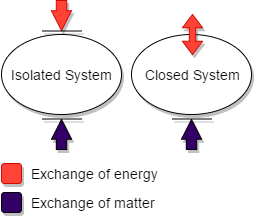Conservation of Momentum Lesson
The Definition of Conservation of Momentum
The law of conservation of momentum tells us that in closed and isolated systems, the sum of all objects' momentum stays constant. This means that momentum cannot be created or destroyed, it is conserved.
Remember that the formula for the momentum of an object is given as:
p = m×v
Where p is the object's momentum, m is the object's mass, and v is the object's velocity.
In a collision between two objects, the decrease in one object's momentum is equal to the increase in the other object's momentum. In fact, this transfer of momentum can happen between any number of objects within a system.

Conservation of Momentum Equation
The general equation for conservation of momentum during a collision between n number of objects is given as:
$$\begin{align} & \sum\limits_{i=1}^{n}[m_{i} \times v_{i_{a}}]=\sum\limits_{i=1}^{n}[m_{i} \times v_{i_{b}}] \end{align}$$
Where mi is the mass of object i, via is the velocity of object i before the collision, and vib is the velocity of object i after the collision.
This formula is given in summation notation, which makes it easy to equate the sum of all objects' momentum before the collision to the sum of all objects' momentum after the collision.
Closed and Isolated Systems
A closed system has no transfer of matter or net force with the outside world. An isolated system has no transfer of matter, net force, or energy with the outside world. Generally, we use closed systems in physics and isolated systems in thermodynamics.

These system types are important to understand because we study momentum problems in simplified versions of reality — closed and isolated systems — so that we only have to keep track of momentum within the system.
In real life, closed and isolated systems do not exist. Even if an object is placed in a remote spot in the vacuum of space, there will be small gravitational forces, electromagnetic energy exchange, and even occasional gas particles interacting with it.
However, we can study physics problems in the context of these systems. We can do so because, in certain situations, the forces, matter, and energy of the outside world are negligible, that is, their effect is so small and minuscule that they can be ignored.
How and Why is Momentum Conserved?
The law of conservation of momentum can be viewed as a result of Newton's second law of motion (F = m×a) and Newton's third law of motion (when an object applies a force to a second object, the second object applies a force back to the first object that is equal in magnitude and opposite in direction).
Let's use Newton's second and third laws to prove that momentum is conserved in the following example problem.
Conservation of Momentum Example Problem
Object #1 has a mass of 2 kg and is moving at 4 m/s when it collides directly with the stationary object #2 which has a mass of 1.5 kg. The collision takes 1 second and has a force of 6 N. Let the positive direction be the direction of object #1's initial velocity. Find the momentum of each object before and after the collision, as well as the total momentum of the system before and after the collision.
Solution:
- First, let's determine the initial momentum of the system. Object #2 has zero velocity and therefore zero momentum, so the momentum of the system is the initial momentum of object #1.
ptotala = p1a
p1a = m1×v1a
p1a = (2 kg)×(4 m/s) = 8 kg·m/s
ptotala = 8 kg·m/s - Now, let's calculate the acceleration and change in velocity that occurs during the collision. We will use Newton's second law, F = m×a, to find acceleration. We will use Newton's third law for the direction of force. Object #1 applies a force to object #2 in the positive direction, while object #2 applies a force equal in magnitude to object #1 but in the negative direction. Rearranging the force equation and solving for acceleration, we get:
a = F/m
a1 = F/m1
a1 = (-6 N)/(2 kg) = -3 m/s2
Δv1 = a1×t
Δv1 = (-3 m/s2)×(1 s) = -3 m/s
a2 = F/m2
a2 = (6 N)/(1.5 kg) = 4 m/s2
Δv2 = a2×t
Δv2 = (4 m/s2)×(1 s) = 4 m/s - Now we can add each object's change in velocity to its initial velocity to find the final velocity.
v1b = v1a + Δv1
v1b = (4 m/s) + (-3 m/s) = 1 m/s
v2b = v2a + Δv2
v2b = (0 m/s) + (4 m/s) = 4 m/s - We have everything we need to solve for the final momentum values.
p1b = m1×v1b
p1b = (2 kg)×(1 m/s) = 2 kg·m/s
p2b = m2×v2b
p2b = (1.5 kg)×(4 m/s) = 6 kg·m/s
ptotalb = p1b + p2b
ptotalb = (2 kg·m/s) + (6 kg·m/s) = 8 kg·m/s
ptotalb = ptotala - We have now solved the individual and total momentum before and after the collision using Newton's second and third laws. The total momentum after the collision (8 kg·m/s) is equal to the total momentum before the collision (8 kg·m/s), so momentum was conserved.

